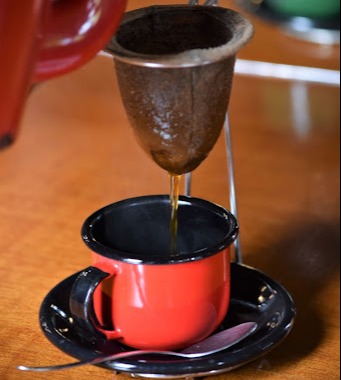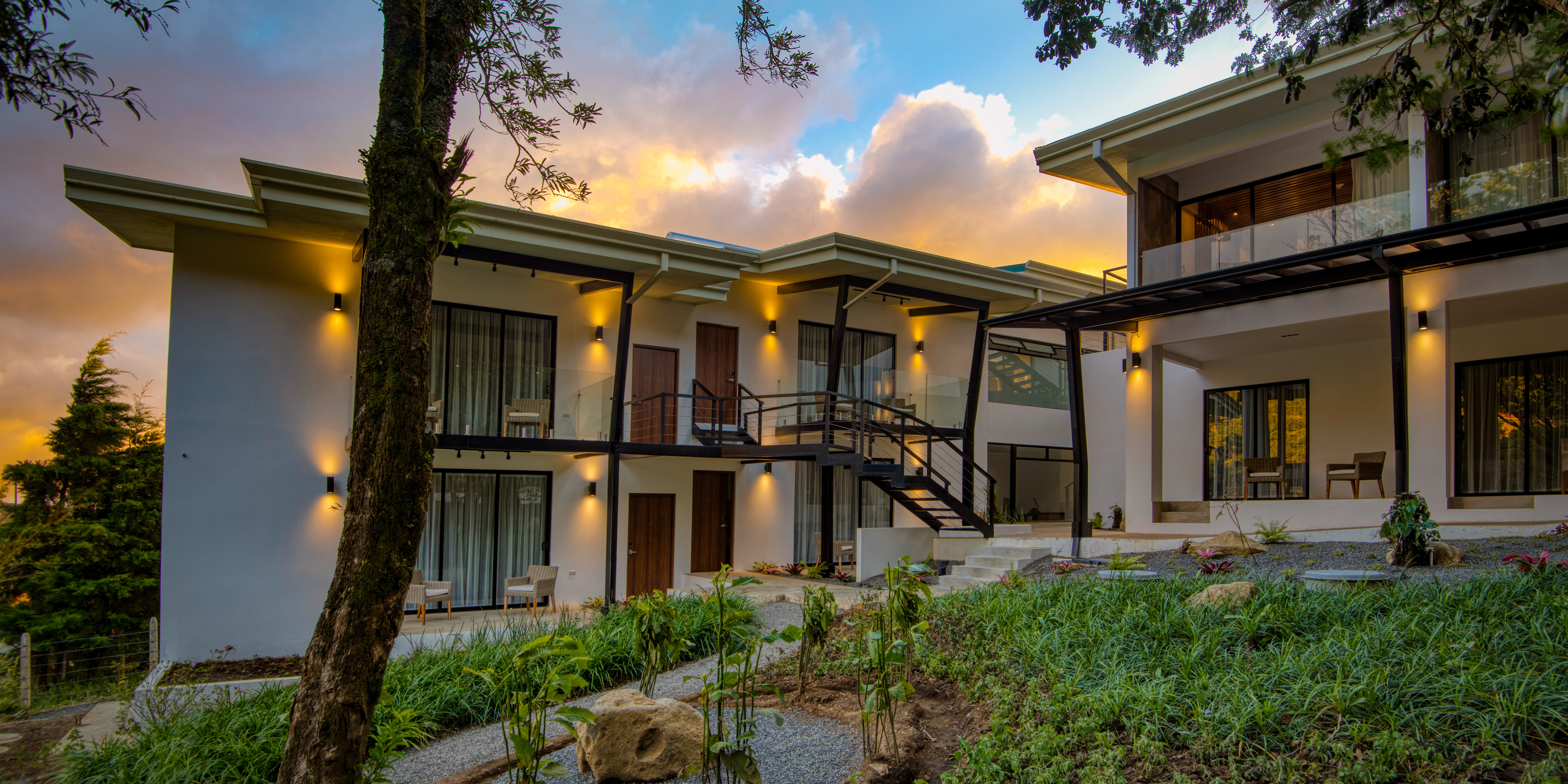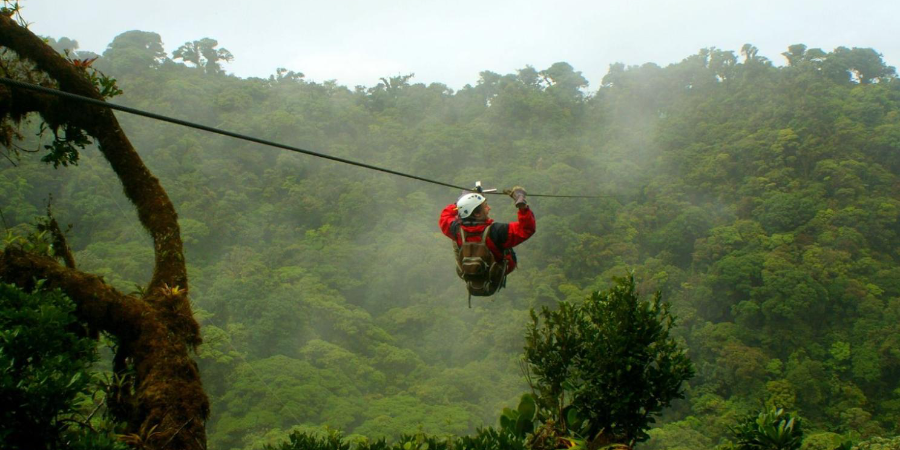Nectar of the Gods- The Story of Costa Rican Coffee

Coffee. Nectar of the Gods. Giver of life. For many, this rich warm brew is the catalyst that starts their day. The magic that pries their eyes open, and helps them face the morning. There is something comforting about the distinctive scent of fresh ground coffee, and the steady drip of the brewing process.
While the process of coffee making in Costa Rica is quite different from what I was used to in North America, the connection to it, and desire for it, remains. As a semi-retired woman, I no longer need it to kickstart my workday… but I still want it!

Why? Because Costa Rican coffee is some of the best in the world!
I have access to fresh, dark, rich Costa Rican coffee every day, and I’m going to enjoy it… one yummy cup at a time. Unlike the various North American methods of coffee brewing from perked, to french pressed, to little prepackaged pods, coffee making here is utterly simple.
You grab a cup. You grab a coffee sock. (not the kind you put on your feet- a tube of simple cotton fabric sewn into a tube with a closed bottom called a colador or bolsa). The top is stretched over a circular wire frame with a hook on one end. If you’re feeling fancy, you hang the hook on a wooden frame made for that purpose, (called a chorreador). If you aren’t feeling fancy, you pop the sock in your cup. Then you measure some coffee grinds into your sock, pour hot water in until the cup is full.
Then you stand over your cup with a groggy smile on your face sniffing the rich aroma for a few minutes while you pry your eyes open. Remove the sock, add your sugar or cream, and voila! Fresh arabica. It may not be fancy, but you can’t beat the flavor!

A Brief History of Coffee in Costa Rica
Coffee is not indigenous to Costa Rica, so unlike with cacao, I have no fun story about the legend of the coffee bean to share with you. (sigh)
It arrived in the 1700s, from Cuba, brought in to see how well it would grow.
The answer was- incredibly well. By 1808, the Costa Rican Government realized the impact this amazing new crop could have on the country’s economy. Then-Governor Tomás de Acosta encouraged citizens to plant the crop by offering free land to coffee farmers, and production took off.
By 1821 there were a reported 17,000 coffee trees producing beans. The best coffee grows at altitudes of 1200 to 1700 meters, and thanks to the country’s year-round warm weather, rich volcanic soil, and many mountain slopes, these trees could be harvested three times a year.
The sheer volume of beans produced meant a need for improved infrastructure, roadways, and even railroads, so you could say the coffee industry has shaped the country.
The Instituto del Café de Costa Rica (ICAFE) was established in 1933 to support the industry’s commercial and agricultural development. They even established a law in 1989 that prohibited farmers from growing the robusta strain of coffee beans, so that only the best arabica beans could be used. Talk about dedication to quality!
In 1829, coffee surpassed sugar cane, tobacco, and cacao as the country’s number one export. In 1832, the beans were exported to Chile and Panama. From Chile, the beans were imported to England, where the population instantly took a liking to it.
The British Market was huge and the golden age of coffee production began. The Costa Rican economy thrived, thanks to the ‘golden harvest’ as it’s called, until WWII when the British Army began rationing their supplies and demand dropped dramatically.
Fun Facts
- Costa Rica is famous for its brightly coloured Oxcarts… but did you know that the carts were brought here by the Spanish in order to help move the coffee beans to the coast?
- The Tarrazú region is thought by many to make the best coffee because they are at the highest altitude. For a while back in 2012, the most expensive beans sold at Starbucks were the Tarrazú Geisha!
- In parts of Costa Rica, growers harvest the beans three times per year. The January harvest produces the biggest crop… so big in fact, that workers are brought in from neighboring countries to help out. The beans are picked, processed, and packaged within 24 hours! No wonder it tastes so fresh!
- Costa Rica exports between 1.2-1.5 million bags of coffee annually!
- Most of those beans are still picked by hand by workers carrying big baskets on their backs. Then the beans are transported to beneficios (processing plants) to be washed, depulped, and dried. In some cases, they are still left in the sun to dry.
- More than 70% of Costa Rica’s coffee production follows ‘adaptation actions’ to reduce greenhouse gas emissions (ICAFE, 2015)
- Costa Rica only has around 5 million inhabitants, living in 19,730 square miles…but in 2015 they produced 215,639,213 lbs and exported 131,305,680 lbs of coffee!
- In some cases, coffee beans will actually pick up flavors, not only from the soil but from other nearby crops
Coffee tours are a great way to see for yourself how the beans are collected and processed. You can also discover the various varieties of beans, and the way the different growing regions affect the taste of the beans.
Ask Ocotea Boutique Hotel for great Coffe Tour offers.
-1.png?width=800&name=Fotos%20Ocotea%202%20(86)-1.png)
Growing Regions
There are 8 growing regions for coffee in Costa Rica. Since the altitude and soil content are different in each region, the flavours of the coffee produced also vary.
Central Valley
Location: Central Valley, San Jose, Heredia and Alajuela. Near Irazu, Barva and Poas Volcanoes.
Bean Variety: Arabica
Distinct Geography: 900-1600 meters, two distinct seasons, volcanic soil- produce hard beans
Bean Variety: Arabica
Flavor Characteristic: fruit, chocolate
Aroma: honey
It’s truly amazing to me that the Central Valley, which is home to 70% of the country’s population, can grow coffee too!
West Valley (Valle Occidental)
Location: Naranjo, Sarchi, Grecia, Palmares, Atenas
Bean Variety: Caturra and Catuai
Distinct Geography: several microclimates and an elevation range of 1200-1700 meters, Naranjo orange groves
Flavor Characteristics: mild chocolate, peach, orange, vanilla, and honey
Aroma: vanilla and honey
The West Valley accounts for nearly ¼ of the country’s crop and has produced several Cup Of Excellence Winners!
-1.png?width=800&name=Fotos%20Ocotea%202%20(88)-1.png)
Tres Rios (smallest region)
Location: Cartago, near Irazu Volcano
Bean Variety: Arabica
Distinct Geography: Volcanic Soil, two distinct seasons
Flavor Characteristics: mild with a sweet taste, and bright tempered acidity, long pleasant aftertaste
The Tres Rios growing region (which translates to ‘three rivers’), produces coffee so unique it is recognized as some of the best coffee in the world! This high quality has earned it the nickname “The Bordeaux of Costa Rica.”
Tarrazú (largest region- 35% of crop)
Location: Santa Maria de Dota,San Pablo de Leon Cortés, San Marcos de Tarrazú
Bean Variety: Cattura
Distinct Geography: 1200-1900 meters, nestled in the inner mountains
Flavor Characteristics: dried fruit, cacao, grapefruit, highly acidic
Aroma: Aged Wood, dark chocolate, sweet cane, jasmine
The area of Tarrazú is the largest growing region in Costa Rica, producing 35% of the annual crop. It is also the location of the Coopeterrazu which has been working to improve the conditions for workers and residents for 60 years. They built their own mill and they are currently working to make coffee production more sustainable.
-1.png?width=800&name=Fotos%20Ocotea%202%20(87)-1.png)
Brunca
Location: San Isidro de General, Buenos Aires, San Vito (southern region of the country, close to Talamanca Mountain Range)
Bean Variety: Arabica
Distinct Geography: 800-1700 meters, humid tropical climate
Flavor Characteristics: mild to very sweet, complex citrus flavor
Aroma: orange flowers or coffee jasmine
The Brunca region is made up of three smaller areas, together they have well over 12,000 hectares of coffee trees. These trees are shared by more than 6,800 farms!
Turrialba
Location: Juan Vinas, near Turrialba Volcano
Bean Variety: Arabica
Distinct Geography: 500-1400 meters, volcanic soil
Flavor Characteristics: mild, light, less acidic flavor
Turrialba, which is located closer to the Caribbean coast is home to several interesting archeological sites including the National Monument of Guayabo. You can always combine your love of coffee with a tour of the park and some Pre-Columbian stone objects.
Orosi
Location: Orosi Valley, Cartago, 40 km North of San Jose
Bean Variety: Arabica
Distinct Geography: 1000-1400 meters, influenced by weather systems from both Atlantic and Pacific Oceans, highly fertile volcanic soil
Flavor Characteristics: Intense cacao flavor, noble acidity
Aroma: sweet aroma
Home of the man-made Cachi Lake and the Cachi Dam, which was built in 1970, it was one of the first hydroelectric projects in the country. If dams aren’t your thing, you can also do some whitewater rafting in the Reventazon River which flows through the town.

Guanacaste
Location: Mountainous areas of the Central Volcanic Mountain Range and Guanacaste Mountain Range Even (Although the region is called the Guanacaste Region, it covers the provinces of Alajuela, Heredia and Puntarenas and Guanacaste. See the map above: Monteverde, San Carlos, Sarapiquí and parts of the Nicoya Peninsula)
Bean Variety: Caturra and Catuai
Distinct Geography: 600-1300 meters, high temperature, dry climate produce soft, elongated beans, most beans are grown in the shade of the forest
Flavor Characteristics: soft, full-bodied, light acidity
Aroma: salty, bitter
Guanacaste has a unique climate within Costa Rica. Low annual rainfall amounts have resulted in a tropical dry forest. The area boasts many types of flora that have adapted to the weather pattern and can’t be found anywhere else in the country!
The Kings and Queens of Coffee
It’s really amazing how much coffee one small country can produce- but I’m glad they do! In fact, I’m going to go have a cup right now… just because I can. You can too, the next time you visit the coffee aisle.
Or you can fly on down and stand on the mountainside looking down over the fields of beans with a fresh cup in hand and the sound of birds chirping overhead. That’s the best way to go!
Pura Vida!
**I really just scraped the surface when it comes to coffee knowledge. If you’re interested in learning more, here are some amazing sites that can help you out.
References:
https://en.wikipedia.org/wiki/Coffee_production_in_Costa_Rica
https://www.drivencoffee.com/blog/costa-rican-coffee-origins/
https://ticotimes.net/2020/09/07/the-history-of-coffee-in-costa-rica
https://www.nomadcoffeeclub.com/pages/costa-rica
https://www.embassycrsg.com/history-of-coffee-in-costa-rica.html
https://cafedecostarica.com/en/nuestro-cafe
Colador
Photo by Magali Guimarães from Pexels
Coffee harvest and coffee plantation
Photo by Michael Burrows from Pexels





